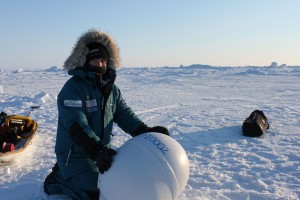In this project we are deploying ice tethered buoys which will measure light and temperature in the water column under the ice to determine how light absorption impacts warming of the Arctic surface waters. Funding is awarded by the National Science Foundation, collaborators are Dr. Mike Steele and Dr. Bonnie Light from the Applied Physics Laboratory, University of Washington.
In spring of 2014 we deployed two systems, the first Northeast of Barrow, Alaska, the second at Barneo (Russian ice camp) 80N and 18E.
The Arctic is considered to be a sentinel system in terms of climate change. The western Arctic in particular has experienced the largest positive anomalies in open water fraction, solar energy input, and sea surface temperature. The attenuation of light in surface waters has been identified as one of the key uncertainties in the modeling of Arctic Ocean physical properties, and has been found to significantly impact the simulation of sea ice thickness and upper ocean heat content. The vertical partitioning of solar radiation absorbed in the mixed layer of the Arctic Ocean, and the type of light absorbing compounds present determine the magnitude of heating.
To understand the following
1. To quantify the connection between seasonal warming of arctic surface waters and the absorption of solar energy
2. To identify the presence and seasonal cycling of materials responsible for this absorption.
3. To develop and deploy proof of concept ice tethered buoys.
Description of WARM buoy
The Warming and Irradiance Measurements (WARM) buoy is designed to collect coincident observations of temperature and light intensity. The buoy string has sensors collecting visible light measurements within the ice at 0.5 and 1.0 m from the ice surface and within the water column at 5, 10, 20 and 50 m from the ice surface. At the 5 m depth a Wetlabs Ecotriplet measures chlorophyll and dissolved organic material fluorescence. Thermistors are located at 2.5, 5.0, 7.5, 10, 15, 20 and 50 m. Two versions of the WARM buoy were deployed a 20 m version used on the shallow Chukchi Sea and a 50 m version deployed at the North Pole and Canada Basin.
The buoy is deployed in early spring (March/April) by drilling a hole through the sea ice (~2 m thick) and feeding the tether through the ice. The surface float is anchored to the sea ice to prevent the buoy from slipping. In the summer the ice melts and the buoy is able to float in open water until the fall when it is frozen back into the ice.
Real time access to data from the buoys can be found here http://psc.apl.washington.edu/UpTempO/Data.php



